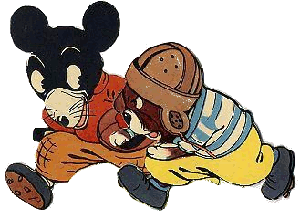
Super Science Sunday
February 4, 2011 This Sunday is Super Bowl Sunday, an unabashed scheme to make a lot of money for a lot of people. The Super Bowl was likely started to generate more interest in football, and it was certainly inspired by the baseball World Series, which was first played in 1903. Football did need some promotion. Baseball teams play nearly two hundred games each year, whereas football teams play only about sixteen; so it's hard to maintain your fan base. The first Super Bowl, Super Bowl I, was played on January 15, 1967, by the Green Bay Packers and the Kansas City Chiefs. The Packers will be playing also in this year's Super Bowl, known as Super Bowl XLV, against the Pittsburgh Steelers. When I was a post-doc at the University of Pittsburgh from 1974-1977, the Steelers had back-to-back wins in Super Bowl IX and Super Bowl X. It's hard to put a STEM (Science-Technology-Engineering-Mathematics) spin on the Super Bowl, although some web sites have tried. Here are a few connections I can think of off the top of my head. February sixth. Nicolaus II BernoulliSwiss mathematician, born on this date in 1695. He was a contemporary of Leonhard Euler and a member of the Bernoulli family noted for many scientists and mathematicians. Charles Wheatstone
English scientist and inventor born on this date in 1802. Wheatstone is famous for the eponymous Wheatstone bridge and the Playfair cipher. Mary Leakey
British anthropologist born on this date in 1913. Leakey was the discoverer of the Paranthropus (a.k.a., Zinjanthropus) fossil. John Crank
British mathematician born on this date in 1916. Crank is known for early numerical computations, especially for solutions of partial differential equations. Gerard K. O'Neill
American physicist born on this date in 1927. O'Neill was an activist for human habitation of space. His views on this matter can be found in his 1976 book, "The High Frontier: Human Colonies in Space." Jun Kondo
Japanese theoretical physicist born on this date in 1930, and best known for the eponymous Kondo effect, which explains the behavior of electrical resistivity at very low temperatures in metals with magnetic impurities. Spencer Silver
American chemist born on this date in 1941. Silver invented the unique adhesive used in Post-it Brand notes. Salvador Luria
Italian biologist and Nobel laureate died on this date in 1991. Luria shared the 1969 Nobel Prize in Physiology or Medicine with Max Delbrück and Alfred Hershey for their work on the molecular biology of viruses. Max Perutz
Austrian molecular biologist and Nobel laureate died on this date in 2002. Perutz worked at Cambridge and shared the 1962 Nobel Prize in Chemistry with John Kendrew for determining the structures of hemoglobin and other globular proteins. I attended a talk by Perutz in 1976, notable for his showing three-dimensional images of molecules to an audience wearing polarizing eyeglasses. Alan Shepard
Alan Shepard was the first man to hit a golf ball on the Moon during the Apollo 14 mission in 1971. His club was a six iron head attached to the handle of a scoop used for a rock sampler. Two actual golf balls were used, and they remain there.[1] Lest you think that only technologists are associated with February 6, Babe Ruth, American baseball player, was born on that date in 1895; Ronald Reagan, 40th President of the United States, was born on that date in 1911; Zsa Zsa Gábor, Hungarian actress, was born on that date in 1917; and Tom Brokaw, American news anchorman, was born on that date in 1940. February 6, 2011, is also Rick Astley's 45th birthday, so you've been Rickrolled!
 | A pun for mathematicians with proper German accents who are long-time football fans. (The Houston Oilers) |
References:
- D.P. Glavin, J.P. Dworkin, M. Lupisella, G. Kminek and J.D. Rummel, "Biological contamination studies of lunar landing sites: implications for future planetary protection and life detection on the Moon and Mars," International Journal of Astrobiology, vol. 3, no. 3 (July, 2004), pp. 265-271, DOI: 10.1017/S1473550404001958
